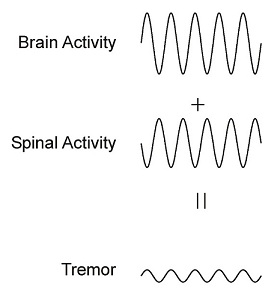Tremor
Have you ever struggled to keep your camera focused whilst shooting a photo? Or noticed your hands trembling when you are tired or nervous? This is normal; everybody shakes and this type of tremor is known as ‘Physiological tremor’. Physiological tremor does not affect the day to day lives of most people but it can become problematic when trying to do very precise actions, such as those required during microsurgery.
If the tremor is large enough to interfere significantly with normal daily activities, it is called pathological tremor. These tremors can be severely disabling, causing problems with simple tasks such as getting dressed or drinking a cup of tea. There are many types of pathological tremors; some are caused by specific diseases whereas others have no obvious cause. In general pathological tremors are hard to treat. Initial treatment is with drugs (e.g. beta blockers such as propranolol) and whilst this can be very effective with some tremors, others do not respond. In severe tremor cases, which are unresponsive to drugs, deep brain stimulation and spinal cord stimulation have been used effectively. However, the effectiveness of treatment is very inconsistent and varies from patient to patient.
So far the evidence suggests that there is not just one source of the tremor within the nervous system. Instead, tremor seems to be the result of complex interactions between multiple circuits within the brain and the spinal cord. We wish to understand theses pathways and interactions more clearly in both physiological and pathological tremors and to use this information to develop novel ways to treat and diagnose these tremors. In order to do this we use a wide variety of different techniques such as electrophysiological recordings, computational modelling, human studies and patient studies.

The characteristic frequency of physiological tremor is 10 cycles per second. Many different parts of the brain also have rhythmic activity at the same frequency. These oscillations may have an important role in normal neural processing but if they spill over into the motor system they may contribute to tremor. We believe that the nervous system has a mechanism which actively tries to prevent this rhythmic activity spreading from the brain to the muscles. One focus of our research has been to identify the source of this active filter.
Our research has shown that rhythmic activity in the brain at 10 cycles per second is cancelled out by similar alternating rhythmic activity in the spinal cord. However, the filter is not perfect and therefore small amounts of the rhythmic activity remain as physiological tremor (see figure above). We are now focused on trying to find ways to control this filter to help reduce the level of pathological tremor in patients (Wearable Device).
People involved in this project
- Dr Elizabeth Williams (Post-doc)
- Demetris Soteropoulos (Post-doc)
- Karen Fisher (PhD student)
- Dr Mark Baker (Supervisor)
- Prof Stuart Baker (Supervisor)
Publications Relevant to this Project
- Williams, E.R., Soteropoulos, D.S. and Baker, S.N. (2010) Spinal interneuron circuits reduce ~10Hz movement discontinuities by phase cancellation. Proc Natl Acad Sci U S A.
- Williams, E.R., Jones, R.E., Baker, S.N. and Baker, M.R.(2010) Slow orthostatic tremor can persist when walking backward.Mov Disord 25: 788-790.
- Williams, E.R. and Baker, S.N. (2009) Renshaw cell recurrent inhibition improves physiological tremor by reducing corticomuscular coupling at 10 Hz. J Neurosci 29: 6616-6624.
- Williams, E.R. and Baker, S.N. (2009) Circuits generating corticomuscular coherence investigated using a biophysically based computational model. I. Descending systems. J Neurophysiol 101: 31-41.
- Williams, E.R., Soteropoulos, D.S. and Baker, S.N. (2009) Coherence between motor cortical activity and peripheral discontinuities during slow finger movements. J Neurophysiol 102: 1296-1309.
- Baker, M., Fisher, K., Lai, M., Duddy, M. and Baker, S.N. (2009) Slow orthostatic tremor in multiple sclerosis. Mov Disord 24: 1550-1553.
Sponsors of this study
Back to the Projects


